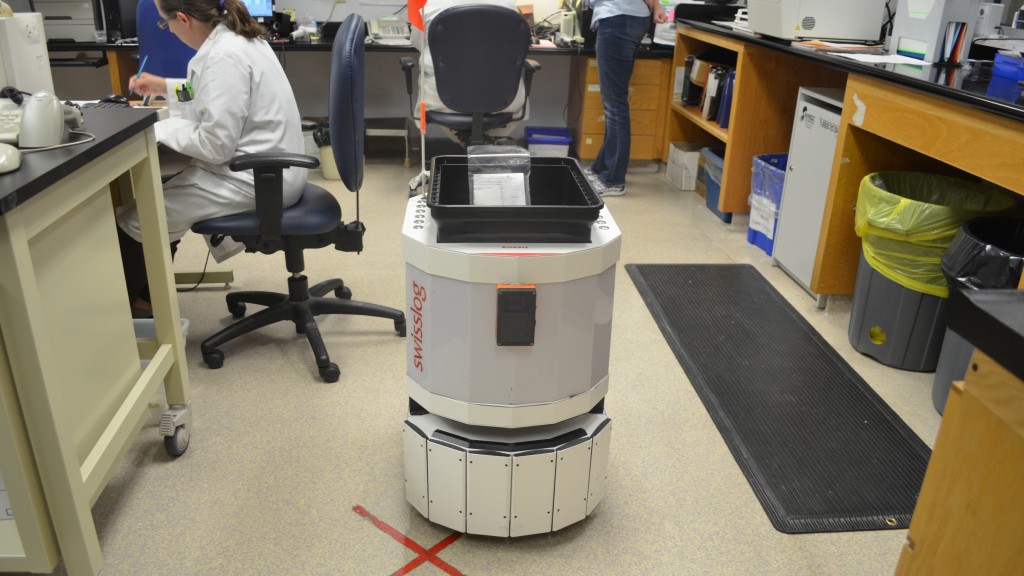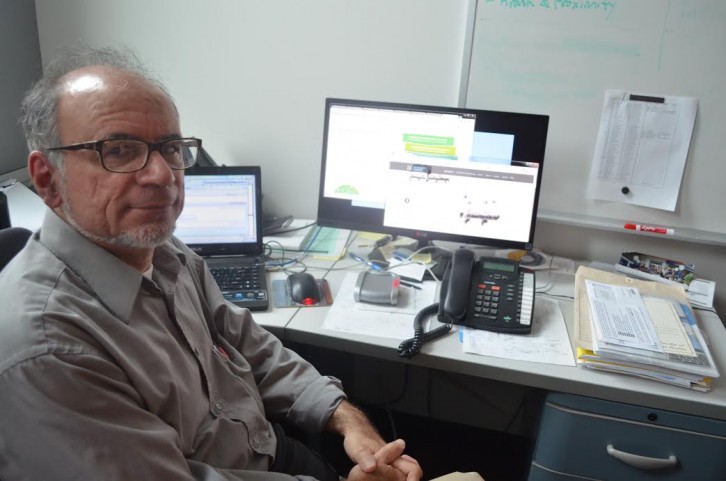Technology
Robots in the newsroom

caption
Robbie delivers between all the different lab units.Are the bots here to help, hinder, or replace?
Robbie has better manners than a lot of people.
He apologizes every time he bumps into anyone or anything. “Ouch,” “Sorry,” and “My bad,” are his only reactions – even if it’s not his fault. Robbie is also polite when he asks if anyone has a delivery for him and when he announces his delivery has been completed.
Robbie has been working at the QEII hospital in Halifax since January 2014, where he delivers samples within the specimen lab to the different departments: chemistry, hematology, and blood transfusion services.
Robbie is a robot.
Robbie is about the size of a keg of beer and has small grey wheels to get him from one place to the other. His destinations are preplanned and marked on the floor of the lab with large red Xs.
Before Robbie started at the QEII, lab assistants did the deliveries. They were making on average 177 trips every day to pick up and deliver samples. Now, with the help of Robbie, they are down to making about 65 trips a day. And those trips are only when Robbie is busy or charging.
Science fiction has predicted robot invention many times in films and novels. In 1950 science fiction author Isaac Asimov set out three laws to govern all robots. The laws were established in the short story Runaround.
The first law of robotics is, “A robot may not injure a human being or, through inaction, allow a human being to come to harm.” The second is, “ A robot must obey the orders given to it by human beings except where such orders would conflict with the first law.” And the last law is, “A robot must protect its own existence as long as such protection does not conflict with the First or Second Laws.”
Science fiction typically imagines robots as independent structures that look like humans and have some form of thought – like 3CP0 of Star Wars fame. Humans have always thought robots would look like metal versions of us.
With robots becoming a reality we can see this is not actually the case. A robot, or “bot,” as they are sometimes called, is any machine programmed to do a specific task automatically. Robbie the Robot looks more like R2D2 than 3CP0, and self-serve checkouts look like regular checkouts without human attendants. And some bots appearing in the workplace aren’t even robots – they’re algorithms.
Paul Acker, supervisor of the Halifax Infirmary Core Lab where Robbie does his deliveries, says Robbie is “a good worker, works all day, 24/7.” He said Robbie is an asset to the department and is saving the lab assistants “a lot of steps.”
However, Robbie is not the only bot in Halifax.
In June 2014 the Halifax International Airport installed self-serve kiosks to allow customers to go through the check-in and baggage processes without the assistance of a human attendant.
Dean Bouchard, Director of Infrastructure at the airport, says the kiosks have not replaced jobs. “The airlines still have as many agents around,” Bouchard said, “but those agents are now more focused on actually helping the passengers and providing a level of service that wasn’t there before.”
Bouchard said the kiosks have cut down wait times for customers. Before the kiosks wait times averaged 10 minutes. This is now down to two minutes.
Robots and automation are not only in the service industries – they are also on social media and in the news.
EQbot came on the scene in May 2009 after Bill Snitzer, and most people in Los Angeles, felt several earthquakes back-to-back. Snitzer, a self-proclaimed “super developer” who has created several other computer programs, says after an earthquake Twitter “blows up” with people questioning whether or not an earthquake has occurred. Snitzer created EQbot because he wanted “something that would answer that question saying, ‘yes, that was an earthquake. Here’s details about it.’”
EQbot is hooked up to the United States Geological Survey (USGS). When USGS registers an earthquake, EQbot takes the data and writes a tweet following a simple structure. EQbot then sends the tweet to Twitter and its hundreds of thousands of followers – all without any human involvement. “Anything that helps get quality accurate news out quickly is a good thing,” Snitzer said.
Speed is crucial when it comes to algorithms. In 2009 Greg Lee, a part-time professor at Acadia University, completed his PhD thesis on machine learning at the University of Alberta. The thesis focused on a program he developed called Scores. This program was able to take statistics from a live sports game and recommend related stories for sportscasters to tell in real time as the game was being played.
Lee says although there are currently similar programs in the sports industry, his is not one of them. Instead, Lee has modified the program and is using it at Fundmetric in Halifax, where he is the lead data scientist.
Fundmetric is a company that uses algorithms to find likely donors for charities. “We’re going to basically apply the Scores techniques to finding out who should be asked to donate,” Lee said, “both in the sense of someone that would give money but also someone wanting someone to ask them instead of ‘leave me alone; I don’t want you to email me anymore’.”
Automated Insights, based in North Carolina, creates algorithms that can synthesize data and compose it into a news story. Algorithms used by Automated Insights work by ingesting data and finding out what the important aspects of the data are based on outliers. If a piece of data stands out among the rest it is likely a relevant and interesting insight. “The third step,” James Kotecki, a spokesperson for Automated Insights, says, “some would call magical, is writing the actual content.”
The writing program used at Automated Insights takes the insights it has gathered from data and turns it into plain language. Importantly, this language is not boring and is done without any help from humans.
These programs are not just fill-in-the-blanks, Kotecki said. “It’s incredibly nuanced and incredibly varied.”
There are two major U.S. companies that work with automated content, Automated Insights being one. The other company is Narrative Science. CEO for Narrative Science, Kris Hammond, predicted in a May 2012 article in Wired that algorithms would win a Pulitzer Prize by 2017. In the same article Hammond also predicted that by 2027 90% of news would be written by algorithms.
On June 30, 2014, the Associated Press announced it would be using Automated Insights to write its corporate finance report stories.
AP declined to comment, saying it could not accommodate an interview request. They redirected the request to this blog post written by Paul Colford, director of media relations at AP.
Before partnering with Automated Insights, AP was putting out about 300 corporate finance report stories per financial quarter. Now, Kotecki said, the company automates 3,000 corporate earnings stories per quarter for AP. “The system would be able to handle more companies if there were more companies,” Kotecki said.
Evangelos Milios, a computer science professor at Dalhousie University, says news-writing algorithms do the work of data mining so humans do not need to search and decode spreadsheets of data, which tend to be difficult. The algorithms take all the data and make it more accessible.

caption
Evangelos Milios says algorithms work with data to create narratives.Milios said these algorithms are very well suited to business and sports news media because of how number-based those two fields are. The algorithms are limited to writing about number-based events and nothing in-depth. “The mundane types of news will probably be taken over by bots,” Milios said, “but the deep and interesting types of news, probably not.” This is because algorithms are set up to process the same type of data in the same order. For deeper or specific news, an algorithm would have to be specifically tailored and it would still not have the deep understanding capabilities of a journalist.
Kotecki said automated news has not replaced any human jobs. Currently algorithms are not capable of answering the ‘why’ and ‘how’ of news articles because those answers are not typically in data. However, Kotecki said “it’s hard to rule anything out in the long term.”
When automated content is written by Automated Insights there is a line at the bottom saying “this story was generated by Automated Insights.” Kotecki said local newspapers are not required to run that line when they receive the content from AP. He said, “It’s possible you read automated content without knowing it.”
Journalists are skeptical of news written by algorithms being in the media.
Located on Maynard Street in Halifax, the Coast has been publishing an alternative weekly newspaper every Thursday since 1993. Christine Oreskovich, publisher of the Coast, says automated news isn’t something the Coast is interested in.
“A large part of what reporting is is talking about numbers,” said Oreskovich, “and if there is no context behind it I don’t think people are being served by their media outlets.”
“Everything we do is produced by Haligonians, so robot reporting for the Coast is not something we’re looking at.”
If this is the first time you are hearing of “robot reporting” and automated news, you’re not alone. Both business editor Joann Alberstat and sports editor George Myrer of the broadsheet Chronicle Herald declined to comment, saying they are not familiar with automated content.
DeNel Rehberg Sedo, professor of communications at Mount Saint Vincent University in Halifax, says algorithmic news is frightening but not surprising. “AP, or news organizations like that, are becoming more and more common as newsrooms lose more and more profit and hire fewer reporters — I think we will see more and more of this.”
Sedo thinks the way newsrooms operate is going to have to change to accommodate fact checking. “If newspaper and other media outlets want to maintain their role in bringing us the news,” Sedo said, “the way a traditional newsroom looks is going to have to reconfigure itself.”
Changing technologies mean people have to adapt. While Robbie the Robot still has his deliveries to different departments at the hospital, it is up to the person sending Robbie to press a button to ensure he goes to the right location.
Robbie can also be controlled from the supervisor’s computer.
Paul Acker, supervisor at the Core Lab, can watch Robbie progress in real time as he travels from department to department. Acker can also alter or stop Robbie’s route from his computer.
Acker said Robbie’s presence has not taken any jobs from human employees. Instead, Acker said, Robbie has “allowed us to expand the duties of the lab assistants that are in there without hiring new staff.”
Although the bots seem to excel at the hospital and airport, Sedo is less optimistic of their role in the news. “I still believe in journalists as our public intellectuals, so I depend on them and their interpretation of the news to help me make a better informed decision,” she said. “I wouldn’t think a bot could do it as well as a human.”
The Coast takes a similar stance. Oreskovich, the publisher, said, “The whole reason the Coast will stay in business, and why we’ve been in business for 21 years, is that we cover local on the ground reporting and we don’t rely on a news service or robots to do reporting.”
Editor’s note: This story was reported and written by Oct. 17, 2014.

